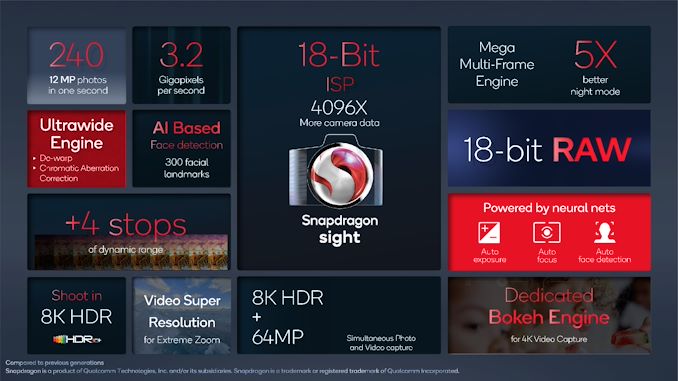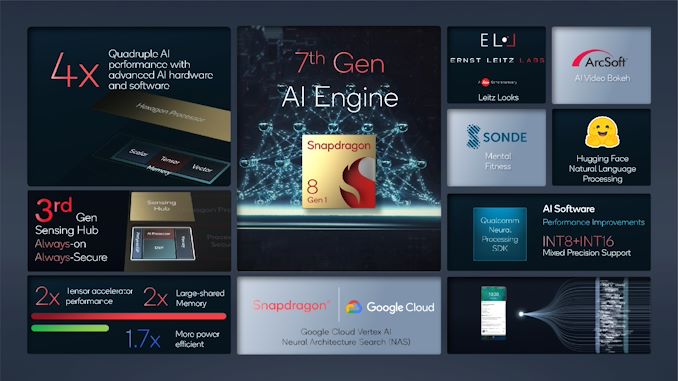Qualcomm Announces Snapdragon 8 Gen 1: Flagship SoC for 2022 Devices
by Andrei Frumusanu on November 30, 2021 6:00 PM ESTMassive ISP Upgrades
I’ve been hearing for some time now that 2022 flagships will have massive camera upgrades, and the new features of the next-gen SoCs being described by MediaTek and now also Qualcomm explain why that is.
The new ISP of the Snapdragon 8 Gen 1 falls under a new marketing name – “Snapdragon Sight”, and includes large improvements of the capabilities of the IP blocks within the image processing chain.
The big flagship feature being advertised is the fact that the new ISP is now capable of 18-bits of color depth per channel, up from the previous generation 14-bit ISP. While mobile image sensors nowadays still are barely 12-bit native in terms of their ADCs, the ushering of new HDR techniques such as staggered HDR capture, where exposures are immediately subsequent to each other on the sensor’s readout, means that new phones now are able to capture images a lot faster, recombining them into higher bit-depth results. Particularly here, the new 18-bit ISP pipeline now allows for three exposure HDR stacking off these new sensors.
The increased bit-depth should allow for an increase of 4 stops in dynamic range (or 2^4 = 16x the range), which greatly helps with very contrasting environments and challenging lighting situations. This is quite beyond any other camera solution right now, and being able to have this implemented in such a hardware fashion sort of blurs the line between traditional image capture techniques and the more software-defined computational photography methods of the last few years.
Indeed, the new ISP architecture seems to be very much a way to implement many of the existing computational photography techniques into fixed-function blocks: there’s a new neural-net controlled 3AA (auto-exposure, auto-focus, auto-white-balance) and face detection block, which sounds eerily similar to Google’s HDRnet implementations.
Night mode is also said to be vastly improved through a new multi-frame noise reduction and image stacking block, being able to now stack and align up to 30 images, and achieve also much finer detail this generation. Qualcomm here claims up to 5x better night mode shots.
Further improvements include a new distortion correction block that’s able to now also correct for chromatic aberrations, and a hardware video Bokeh engine, being able to operate at up to 4K video recording. Think of it as the same as the new Cinematic mode on the new A15 iPhones, but not only limited to 1080p.
Qualcomm notes that all the AI/ML/neural network features on the ISP are actually run and accelerated on the ISP itself, meaning that it is not offloaded onto the Hexagon dedicated ML processing blocks or the GPU.
Just as a note- Qualcomm’s 3.2Gigapixel/s throughput metric here seems low compared to the Dimensity 9000’s 9Gpixel/s, it’s possible that the companies are advertising very different metrics, with MediaTek advertising the throughput of lower-bit depth pixels coming from the image sensors per frame, while Qualcomm quoting the full bit depth pixel processing within the ISP itself.
In terms of video encoders and decoders, the new chip allows for 8K HDR recording now, but otherwise is seemingly on par with the Snapdragon 888 media blocks. Unfortunately, this also means no AV1 decoding this year yet again. Qualcomm isn’t part of the Alliance for Open Media consortium and instead is backing VVC/H.266 and EVC, however with AV1 being actively pushed by Google and YouTube, and seeing large adoptions such as by Netflix, it’s becoming questionable for Qualcomm to still not support the format in 2022 devices.
AI Performance - Iterative, but solid
Last year’s Hexagon IP block was a very large change for the Snapdragon 888. At the time, Qualcomm moved on from a more segregated DSP/AI architecture to a single more fused-together block being able to operate on scalar, vector, and tensor operations at the same time. This year’s iteration is an improvement of that larger change. Qualcomm notes that amongst many changes, they’ve doubled up on the shared memory of the block, allowing for greater performance for larger ML models (which are growing at a very fast pace).
Qualcomm didn’t note any TOPS figures this time around, instead stating we’re seeing 2x the tensor throughput performance, and smaller increases for scalar and vector processing. They do quote a day-1 to day-1 performance increase of 4x when compared to the Snapdragon 888, via a combination of both hardware and software improvements, but of course that figure is smaller when comparing both platforms on an equal software footing.
Power efficiency for AI workloads is said to be 70% better this generation, which is actually more significant, and should help with more demanding sustained ML workloads.
X65 Modem Integrated
In terms of connectivity, the Snapdragon 8 Gen 1 is quite straightforward, as it integrates the X65 modem IP that Qualcomm had already announced as a discrete model earlier this year.
The improvements here are the fact that it’s a 3GPP Release 16 compatible modem, including new features such as uplink carrier aggregation. Other improvements are 300MHz of Sub-6 bandwidth on 3 100MHz carriers, and an increase of the mmWave bandwidth from 800 MHz to 1000MHz, allowing a new peak theoretical downlink speeds of 10Gbps.












219 Comments
View All Comments
mode_13h - Wednesday, December 8, 2021 - link
> How do you think prioritization is IMPLEMENTED at the point that it hits that hardware?The OS scheduler? Well, when a context switch occurs due to a timeslice ending, a thread blocking on I/O or blocking on a synchronization object, the OS decides which (if any) thread should next run on that core.
> Any particular NoC routing point, or the memory controller,
> or any other shared resources has to decide who gets access in what order.
If you can put a FIFO there, that works for anything not time-critical. If you need QoS, then priority queues are a simple way to implement it. When a FIFO isn't appropriate, you need an arbiter which probably looks at priority tags to see who wins, and might use round-robin as a tie-breaker.
> OS scheduling doesn't help here!
I didn't say it did. What I said was that your animations should be light-weight. If they are, then their compute & bandwidth requirements should be easily satisfied by getting a fair allocation (e.g. round-robin) of said resources.
> If you want the hardware to make better choices
Yeah, I get all of that. Again, I was just talking about UI animations. You shouldn't need system-wide QoS tagging of all your bus & memory transactions, just to get some light-weight animations to run smoothly. For the hard-realtime stuff, especially with more stringent compute or bandwidth demands, that's a different story.
> - massive overprovision of HW
And this is effectively what we're talking about, with light-weight UI animations.
egiee - Tuesday, November 30, 2021 - link
Maybe it is the first time that Mediateck can beat Qualcomm in high-end Socs next year.Xedius - Tuesday, November 30, 2021 - link
I know this is off-topic, but should I buy the new Moto G200 with the SD 888+ at $480 or wait for the new SD 8 Gen 1 devices? I'm quite fed up with the Exynos 9810 from my Note 9.egiee - Tuesday, November 30, 2021 - link
you may wait for SM8450 next yeareastcoast_pete - Tuesday, November 30, 2021 - link
At that price, the Moto sounds like good value, if it checks all the important boxes for you. The alternative is to wait for 2022, possibly until Q2 with the ongoing supply mess, and pay at least twice what that G200 apparently goes for now.Kangal - Sunday, December 5, 2021 - link
There's a big difference in performance and efficiency going from 10nm/A75 to the 7nm/A76. But after that, there's a negligible improvement from the QSD 855 to the 855+/860/865/865+/870/888/888+. And there seems to be a performance regression with next year's QSD 8-gen1.So any upgrade is going to feel big, wether it's with next year's chips or ones from a few years ago.
My recommendation is that you instead get the Samsung Galaxy A52-S. It's got 5G, OLED, 120Hz, and the new QSD 778 chip that is equal to the QSD 860 (ergo same as all the other chips).
You'll get a proper flagship phone in the A52-S, without any big compromises like Waterproofing, Headphone Jack, microSD, or software updates (3 years from Samsung).
By the time that gets old, we will get proper ARMv9 chips and devices. This first gen is not impressive at all.
geoxile - Tuesday, November 30, 2021 - link
Pathetic cache configuration.mode_13h - Wednesday, December 1, 2021 - link
Cache uses both area and power. So, increasing cache costs more $ and battery life. The only time that's not true is where cache saves you having to go out to DRAM, although there's going to be a crossover point where adding cache costs more power than the DRAM accesses it saves.michael2k - Wednesday, December 1, 2021 - link
Well, given how small the cache is at 4MB, and how large the DRAM is at 12GB to 16GB, and how much the CPU and GPU both use the cache, I don't see how it's ever going to avoid pulling from DRAM.But if your app + OS can live in 4MB instead of 5MB, you'll definitely see better battery life.
eastcoast_pete - Tuesday, November 30, 2021 - link
I know this is probably the least interesting part of this new SoC for many, but I would love to try out the 720p at 960 fps "infinite recording" capability.Being able to do that let's one catch that wanted sequence of frames without worrying about starting too late or running out of the few seconds of buffer. Andrei, when you review a smartphone with one of those, can you try and play with that feature and let us know?